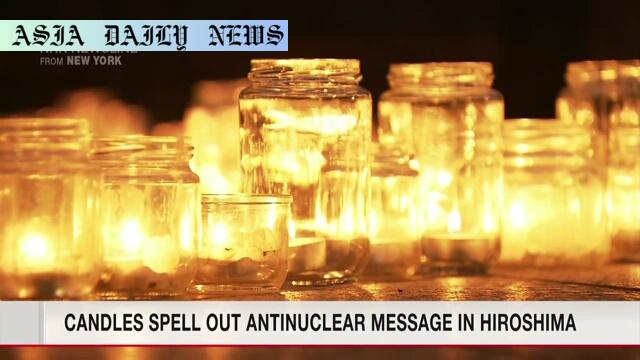Civic group members gather in Hiroshima to mark the Treaty on the Prohibition of Nuclear Weapons’ fourth anniversary with a candle-lit message.
A candle-lit message urging nuclear abolition was displayed in Hiroshima.
The event marks the fourth anniversary of the Treaty on the Prohibition of Nuclear Weapons.
Speakers called for collective global action to eliminate nuclear weapons.
Participants emphasized supporting victims of nuclear-related activities worldwide.

Marking the Fourth Anniversary of the TPNW
The fourth anniversary of the Treaty on the Prohibition of Nuclear Weapons (TPNW) was commemorated in Hiroshima with a poignant and powerful event. On January 22, approximately 50 people gathered in front of the Atomic Bomb Dome, a prominent symbol of the devastation nuclear weapons inflict, to make an urgent call for global nuclear disarmament. This event was a moving reminder of the need to strengthen efforts for nuclear abolition and to reassess humanity’s relationship with such weapons.
A Candle-Lit Plea for Humanity
The Hiroshima Alliance for Nuclear Weapons Abolition, the event organizers, orchestrated an astonishing tribute of light and hope. This included the lighting of 1,500 candles shaped into the words: “Nuclear & humanity can’t coexist!” Through this display, activists sought to visually resonate with the public, emphasizing that nuclear weapons pose an existential threat to human survival. The haunting, yet beautiful sight reinforced the shared responsibility of humanity to contemplate the far-reaching consequences of nuclear armament.
Reflection on Global Nuclear Threats
A statement was read aloud during the event, highlighting the continued threat of nuclear wars. The message referred explicitly to state parties preparing for the upcoming TPNW meeting in the United States this March. It called upon participants to implement measures that not only help victims of atomic bombings but also address the suffering of individuals impacted by uranium mining, nuclear testing, and other related activities worldwide. These sentiments underline the comprehensive responsibility the global community has toward eradicating nuclear weapons and addressing the consequences of their production and use.
Civic Leaders Amplify the Call
Co-representative of the Hiroshima Alliance, Moritaki Haruko, underscored the ongoing defiance shown by some countries toward the international treaty banning nuclear weapons. According to her, this resistance reveals an urgent need for vigilant action. Moritaki emphasized that Hiroshima stands as a symbol of resilience and collective strength. She urged citizens to join hands firmly, advocating for a future free from the specter of nuclear annihilation.
Reflection on Hiroshima’s Symbolism
The location of the event—a city still carrying scars from the atomic bomb dropped during World War II—served as a potent reminder of the reality of nuclear violence. Hiroshima stands as both a cautionary tale and a beacon of hope, continually urging the world to heed its lessons. The emotional weight of the event, paired with its peaceful yet strident message, offers a pathway for international discourse surrounding nuclear abolition.
Looking Ahead to the United Nations Meeting
While the Treaty on the Prohibition of Nuclear Weapons has been a milestone in the global abolition movement, its implementation still faces significant hurdles. The upcoming TPNW meeting in the United States in March provides an opportunity for dialogue and conviction among state parties. By spotlighting those affected by all stages of the nuclear lifecycle— from uranium miners to nuclear bomb survivors—activists and global leaders have a responsibility to push forward a unified agenda for eradication. Events like this in Hiroshima remind the world of the magnitude of the challenge ahead.



Commentary
Resonating with Hiroshima’s Legacy
The candle-lit event in Hiroshima serves as a profound gesture, amplifying the urgent need for nuclear disarmament. As the first city ever to experience the horrors of an atomic bombing, Hiroshima holds unique emotional and historical weight in the global effort against such weapons. Witnessing such impactful acts—like the formation of powerful messages using candles—reminds the world of the catastrophic consequences tied to nuclear weapons and the responsibility we share in preventing their use.
The Relevance of the Treaty
The Treaty on the Prohibition of Nuclear Weapons marked an extraordinary step forward in international disarmament efforts. However, its impact remains limited as some of the largest nuclear powers refuse to recognize it. This creates a dissonance where the voices of survivors and victims—like those in Hiroshima—often go unheard. Events like this candle-lit vigil play a critical role in keeping the conversation alive, especially as global tensions related to nuclear armament show little sign of abatement.
A Call for Global Unity
At its core, the issue of nuclear weapons is a question about the survival and moral choices of humanity. Can we afford to continue down a path threatened by the specter of nuclear war? As Hiroshima stands resilient in its message of peace, the world must acknowledge its symbolic power and ethical imperative. Collective actions, like those inspired by the Hiroshima Alliance for Nuclear Weapons Abolition, should be amplified and celebrated to spark momentum for change.
Moving Forward
Ultimately, the pathway to a nuclear-free world is fraught with challenges, but Hiroshima’s symbolic event instills hope. As the global community prepares for the upcoming United Nations conference, one can only hope such advocacy makes a lasting impact, aligning leaders and citizens alike toward a shared goal of abolition, justice, and peace.